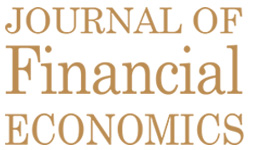

| Social Science Citation Index Journal Rankings, 1994-2020 | |||||||
|---|---|---|---|---|---|---|---|
| This information comes from the most recent (1994-2020) editions of the Journal Citation Reports, published by the Institute for Scientific Information. Information is excerpted from the Business Finance and the Economics lists of journals. The rankings are based on "impact factor," which is the average number of citations received in 2020 by papers published in 2019 and 2018, for example. Also shown is the citation half-life, which gives the age of the article that accounted for the median citation during the year (so journals with prominent older articles have longer half-lives). Note that we have discovered some apparent errors in the calculation of the 1998 and 1999 impact factors for the JFE and show both the original and corrected data below. |
|||||||
| Journal of Financial Economics | |||||||
| JCR Year |
Business Finance Rankings |
Economics Rankings |
Impact factor |
5-Year Impact factor |
Citation Half-life |
Normalized Eigenfactor Score |
Rank among all SSCI Journals based on Normalized Eigenfactor |
1994 |
4 |
9 |
1.667 |
8.7 |
|||
1995 |
1 |
6 |
2.138 |
9.4 |
|||
1996 |
1 |
5 |
2.609 |
>10 |
|||
1997 |
1 |
6 |
2.506 |
>10 |
|||
1998 |
2 |
11 |
1.942 (corrected) 1.767 (as published ) |
>10 |
|||
1999 |
2 |
11 |
2.029(corrected) 1.705 (as published) |
>10 |
|||
2000 |
2 |
11 |
1.904 |
>10 |
|||
2001 |
2 |
3 |
2.577 |
>10 |
|||
2002 |
2 |
3 |
3.248 |
>10 |
|||
2003 |
3 |
5 |
2.723 |
>10 |
|||
2004 |
2 |
6 |
2.551 |
>10 |
|||
2005 |
2 |
8 |
2.385 |
>10 |
|||
2006 |
4 |
9 |
2.494 |
>10 |
|||
2007 |
3 |
5 |
2.988 |
>10 |
|||
2008 |
2 |
6 |
3.542 |
5.203 |
>10 |
||
2009 |
1 |
3 |
4.020 |
5.675 |
>10 |
||
2010 |
3 |
8 |
3.810 |
5.631 |
>10 |
||
2011 |
3 |
8 |
3.725 |
5.676 |
>10 |
||
2012 |
3 |
10 |
3.424 |
5.087 |
>10 |
||
2013 |
2 |
6 |
3.769 |
5.719 |
>10 |
5.88 | 4 of 3,049 |
2014 |
2 |
5 |
4.047 |
5.876 |
>10 |
6.49 | 4 of 3,154 |
2015 |
2 |
13 |
3.541 |
5.833 |
>10 |
6.79 | 4 of 3,221 |
2016 |
2 |
6 |
4.505 |
6.991 |
>10 |
7.40 | 4 of 3,236 |
2017 |
2 |
9 |
5.162 |
7.513 |
13.5 |
6.74 | 5 of 3,304 |
2018 |
4 |
15 |
4.693 |
7.976 |
13.5 |
6.35 | 7 of 3,382 |
2019 |
3 [this would be 2 if SSCI had not started including Forbes Magazine in its rankings] |
8 |
5.731 |
8.804 |
13.6 |
6.37 | 9 of 3,485 |
2020 |
3 [this would be 2 if SSCI had not started including Forbes Magazine in its rankings] |
13 |
6.988 |
11.164 |
13.7 |
11.682 | 10 of 3,510 |
| The Eigenfactor Score calculation is based on the number of times articles from the journal published in the past five years have been cited in the JCR year, but it also considers which journals have contributed these citations so that highly cited journals will influence the network more than lesser cited journals. References from one article in a journal to another article from the same journal are removed, so that Eigenfactor Scores are not influenced by journal self-citation. The Normalized Eigenfactor Score is the Eigenfactor score normalized by rescaling the total number of journals in the JCR each year so that the average journal has a score of 1. Journals can then be compared and influence measured by their score relative to 1. For example, if a journal has a Normalized Eigenfactor Score of 5, that journal is considered to be 5 times as influential as the average journal in the JCR. | |||||||
| Click here for a graph showing the impact factors for the JFE , the Journal of Finance , the Review of Financial Studies , and the Journal of Financial and Quantitative Analysis .
|
|||||||
| Click here to download the graph of SSCI Total Citations in PDF format. |
|||||||
| Click here to download the graph of SSCI Immediacy Indexes in PDF format. |
|||||||
| Click here to download the graph of the Number of Articles Published according to the SSCI in PDF format. |
|||||||
Google Scholar Journal Rankings, 2021 |
|||||||
| Google Scholar ranks finance and economics journals based on the "h5-index." The h5-index is the h-index for articles published in the last 5 complete years. It is the largest number h such that h articles published in 2016-2020 have at least h citations each. As of June 2021, the JFE ranked first in Finance and is ranked second in the "Business, Economics & Management" category.
|
|||||||